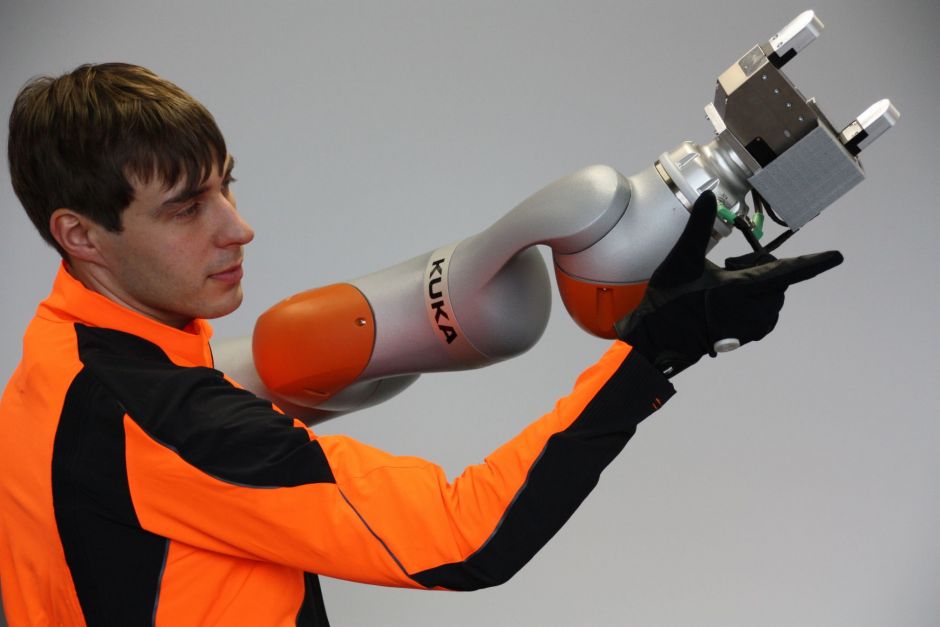Paradigm shift: Can anyone be a robotics programmer with sensor-embedded clothes?


Robotics
One of the fastest-growing tech startups in Germany is a company that helps people program robots without writing a line of code. Only a year old, the quick success of Dresden-based Wandelbots, which just raised €6 million in a Series A, points to a massive untapped global market for industrial automation, which until recently has been the purview of large companies that can afford on-site integration specialists.
The basic problem is that industrial robots currently have to be hardcoded to perform tasks. Programming languages vary widely between robotics companies, meaning platforms from Kuka, ABB, and Fanuc all have different interfaces and require different specialists to engineer the control software. Because industrial lines frequently change or retool, the programming process has to be repeated at great expense.
All of this has had a significant impact on global supply chain economics. The expense of bringing a robot online is prohibitive for all but the largest operations, and even they are loath to produce small batches in part because of the embedded setup costs. (In many cases materials costs are another reason.)
"Today, robots are only accessible to companies with long-running low-mix, high-volume production," explains Christian Piechnick, CEO of Wandelbots. "As more than 70% of costs are directly related to the software controlling the robot, they're unattractive for the production of small batch-sizes."
Companies making smaller collaborative robots, which are suitable for desktop production such as components manufacturing but not for heavy industry, have incorporated varying degrees of a functionality called Programming by Demonstration (PbD) into their platforms. In most applications, the user will physically move a small collaborative robot through the required tasks. The robot remembers the sequence of movements and the user tweaks paths and speeds via a programming interface to fine tune performance.
PbD is still clunky, but it has unquestionably aided adoption of collaborative robots by reducing setup time and cost. Industrial robots, which are too big and often work with loads that are too great to allow physical walk-throughs, still require coding.
Wandelbots' solution is sensor-attached jackets and gloves that track human motion in real-time and translate it into machine commands.
"We've developed a universal language for robots based on smart clothing," says Piechnick. "Anyone, regardless of their technical or cultural background, can now teach any robot in the most natural, intuitive way -- by demonstration."
Must read
- 5 things to know about soft robotics TechRepublic
- Meet Loomo, Segway's personal mobile robot TechRepublic
- Sophia the robot walks for the first time CNET
- Misty the adorable robot just wants to be your friend CNET
Part of the secret sauce lies in the way the Wandelbox, which is the company's first product, optimizes commands based on multiple demonstrations. Rather than blindly parroting the user, Wandelbox's machine learning kicks in and begins making assumptions about the task and objectives to generate optimized solutions.
Crucially, the scripts are platform-independent and can be automatically transformed into platform-specific robot code.
"In order to offer competitive products in the face of the rapid changes within the automotive industry, we need more cost savings and greater speed in the areas of production and automation of manufacturing processes," said Marco Weiß, Head of New Mobility & Innovations at Volkswagen Sachsen GmbH.
Wandelbots teamed up with Volkswagen beginning last year to explore Human-Robot Collaboration applications within Volkswagen's Transparent Factory Dresden.
Beep Boop Bop: A brief history of robots, Part I
Previous and related coverage:
Robotics in business: Everything humans need to know
An executive guide to the technology and market drivers behind the $135 billion roboticsmarket.
Living Machines: A quick history of robots (Part I)
Derided as abominations or celebrated as ingenious feats of human engineering, robots have been around longer than you think.
Wanted: Robot life coach (no, really)
The unique job is a hint of what's to come as robots increasingly join us in the human world
Gorgeous robots made of high tech paper are mesmerizing
Fifty students were given this shapeshifting paper and told to let their imaginations run wild. Here's what they came up with.